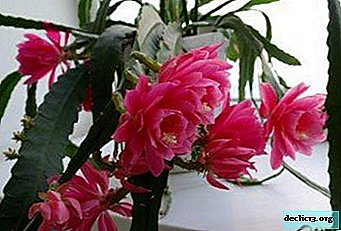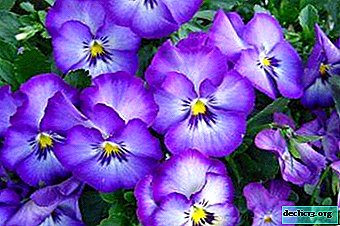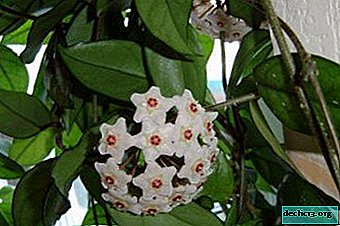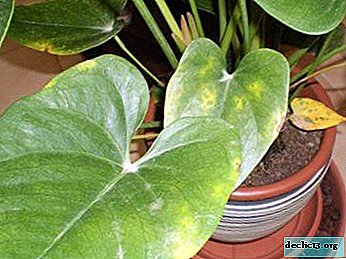Exotic Indoor Flower Anacampseros: Species, Care and Reproduction
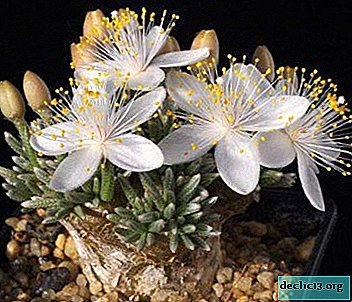
The genus Anacampseros originates from countries that we are accustomed to consider exotic: these are Australia, the states of South and Central America, and the south-west of the African continent.
The representative of the "returning love" plants belongs to the well-known Portulakova family.
More recently, a curiosity such as Anacampseros appeared in our homes. Therefore, many gardeners are still interested in the care and cultivation of this plant.
This article will tell you about the main varieties, the rules for the care, cultivation and reproduction of such exotic species as Anacampseros.
Description
Recently, this plant belongs to the genus Anacampseros. This genus has a little more than five dozen varieties of perennial plants and shrubs. The highest height that the described plant reaches is 12 cm. The main residence of the Anacampseros clan is the southern side of the Earth.
Anacampseros perfectly adapted to life in arid and very hot areas of our planet due to the fact that the rhizomes are located on the surface of the soil.Leaf plates are the most diverse: small flat or large fleshy, can be in the form of a circle, ellipse, wedge. Leaves differ not only in shape and size, but also in color: among the leaves you can find all shades of green and plus pink, purple, cherry and red. In addition to an interesting color on the leaves, there may be various pigmentation. Often the whole aerial part of the plant is pubescent.
Flowers appear on graceful flower arrows. The buds themselves are often pure white, but sometimes there are pale pink and pale red.
A characteristic feature of the flowering of Anacampseros is that the buds open only after lunch and only for several hours. Grow such a flower for a very long time: about ten years.
Varieties of Anacampseros
Alstonii (Alstonii)

Often grow Alston at home amateur gardeners fail. Alston during its development is very slowly building up the Cudex.
The stems of Alston are very short and narrow, but there are a lot of them. These shoots are densely covered with the same small leafy plates.Flowers of white, less often - pink and purple color, are formed at the very tops of the stems.
Retusa (Retusa)

The plant has a compacted root. Leaf plates grow very closely to each other, leaving the outlet, and have a different color: from just green to dark purple.
Over time, Retuza turns into a bush plant. Absolutely the entire surface of the flower is covered with a small soft pile. The maximum height of Retuza is 10 centimeters.Retuza flowers are small - about 1-1.5 centimeters. The flower has a bright pink tint.
Tomentosa (felt) (Tomentosa)

The stem of this species grows up to 5 centimeters in height. Leaves can be recognized by green color with a brownish overflow.
Tomenoza leaves are oval in shape with a pointed end, very oily, but very short - just one centimeter in length.Flower shoots reach six centimeters in height, pink buds about three centimeters in diameter bloom on them.
Namaquans (Namaquensis)

The plant lives in western South Africa. The root system with the development of the flower turns into one continuous thickening.
The stem of Namakwan anacampersosa begins to branch even at the base. The leaf plates are almost spherical, they are also covered with whitish soft bristles.Flowers grow up to three centimeters in diameter. Namakwan Anakampseros flowers have a deep pink color.
Filamentosa (Filamentosa)

It features a very tiny size. The root system has been converted to one seal.
The stalk shoots of filamentous anacampersos are very short; oval leaves with a pointed end grow very densely on them, which are also convex on both sides.A distinctive feature of filamentous Anacampseros is the gray-white threads that encircle the entire flower in a circle. On one peduncle, it can simultaneously dissolve from 3 to 5 flowers that have long petals of pink, and sometimes even purple.
Reddish (Rufescens)

Rhizomes grow on the surface, for them you need to pick up a small pot. The stems reach eight centimeters in height and only in the first year they grow evenly, and then begin to hang down.
The leaf plates of the Reddish Anacampseros are oblong, very oily, have a juicy green color on top and a reddish bottom. From the sinuses, you can observe long, thin villi.Anacampseros reddish blooms with delicate pink and purple flowers. The flowering time of the Reddish Anacameros from September to May.
Telephiastrum

It is considered one of the largest varieties. The leaf plates are not pubescent in any way; they have a shape similar to an egg with a very pointed end. In all the leaves are collected in a basal rosette. Short leaf villi grow in the sinuses.
Nude (Subnuda)

Naked anacampersos can be found in all parts of South Africa.. Leaf plates are also ovoid, very oily, small in size. Gradually, the lower leaves lose pubescence. Hence the name of the flower variety.
Paper (paper-like) (Papyracea)

The stems grow to only 5-6 centimeters in height and one centimeter in diameter. Leaf plates are small, pale green, oblong in shape. These leaves are covered over the entire surface with stipules, which are similar in appearance to paper. White buds with green tints.
Care
Lighting
Firstly, it should be a lot. And secondly, it should be direct, without any shading. But there is an important condition: after the winter period, you need to accustom the plant to light gradually.
With a lack of natural light, you can turn to artificial for help.Temperature
The optimal air temperature for Anacampseros is 22-25 degrees above zero. But since mid-autumn (just at that time flowering ends), the temperature in the room must be reduced to 15-17 degrees Celsius. Thus, a signal is sent to the plant that a dormant period is beginning.
Location
As for the location of the flower in the room, you need to choose the south side (in extreme cases, the southeast). It is advisable that the flowerpot with the plant stood on the windowsill itself.
Watering
 Moisturize the soil should be quite plentiful. But this should not be done until the soil is completely dry from the previous watering. Starting in October, watering should be reduced to a minimum: Once a month will be enough.
Moisturize the soil should be quite plentiful. But this should not be done until the soil is completely dry from the previous watering. Starting in October, watering should be reduced to a minimum: Once a month will be enough.
In summer, anacampersos is watered every 10 days - 2 weeks, waiting for the topsoil to dry out. From September to mid-November and from mid-March to May - once a month. In winter, the succulent anacampersos practically does not need watering.
Air humidity
This is the point of care in which the plant will absolutely not care. The flower is comfortable both in dry air and in wet.
Top dressing
You need to start fertilizing the soil no earlier than April. "Feed" the plant is recommended no more than once a month. You need to purchase ready-made nutritional complexes for cacti, but at the same time reduce the concentration by half. It is necessary to ensure that nitrogen does not prevail in the fertilizers, as this can lead to decay of the entire root system.
The soil
The soil should have a neutral or weak pH. Drainage should be as much as possible.
It is better to buy ready-made substrates. But you can prepare the soil mixture yourself: for this you need to take turf and leaf land, river sand, charcoal and a coarse-grained layer of pebbles in the proportions of 2: 2: 1.5: 0.5: 0.5.Pruning
This process should not be frequent. It’s enough to pinch a plant once a seasonso that it does not go up in thin shoots, but more bush.
Breeding
Reproduction by seeds is the surest way to get offspring from Anacampseros. You can collect the seed during the flowering of the plant. But do not allow the box to fully open. Then, most likely the seeds will sprout right in the pot of the mother's flower.
 Sowing seeds is recommended between late spring and mid-summer. The soil mixture should consist of sand and peat. The optimum temperature for seeds ranges from 18-21 degrees of heat. It is necessary to spray the seeds every 5-7 days. Usually already on the sixth day you can see the first shoots of Anacampseros. At this time, seedlings need to be transferred to a well-lit place and begin to constantly abundant soil moisture. After another week, you can dive.
Sowing seeds is recommended between late spring and mid-summer. The soil mixture should consist of sand and peat. The optimum temperature for seeds ranges from 18-21 degrees of heat. It is necessary to spray the seeds every 5-7 days. Usually already on the sixth day you can see the first shoots of Anacampseros. At this time, seedlings need to be transferred to a well-lit place and begin to constantly abundant soil moisture. After another week, you can dive.
There is still such a method as cuttings. To get new shoots, you need to select young cuttings and put several of them in one container. Prepare the same conditions as for the seeds.
Transfer
The described plant does not like to change its place of residence for no apparent reason. Therefore, it is better to transplant Anacampseros no more than once every three to four years. This should be done in early spring at the end of the dormant period of the flower.
It is necessary to get the plant out of an absolutely dry substrate and transplant it into still dry soil. Moreover the first watering should be no earlier than a week after the transplant, and not very plentiful.
Diseases and Pests
The main disease of Anacampseros is the decay of the root system.This happens for several reasons:
- too much watering;
- missing or a small drainage layer;
- low air temperature;
- high level of humidity;
- an excess of nitrogen in the substrate.
To combat this disease, you need to urgently transplant a plant.
The main pest of Anacampseros is considered to be a mealybug. If this parasite is detected, immediately remove the affected areas, and treat the healthy plant with a soapy solution. If such measures do not lead to positive results, you can resort to spraying with any insecticidal drug. If this measure of treatment does not help, then you will need to use a solution of nicotine sulfate (at a concentration of 0.20%).
Possible growing problems
 As already mentioned, Anacampseros is an exotic plant and therefore requires special attention and special care..
As already mentioned, Anacampseros is an exotic plant and therefore requires special attention and special care..
If the grower does not comply with at least one of the above items for caring for this plant, it will quickly die without the possibility of resuscitation. Therefore, if you have already decided to purchase such an exotic, then get ready for some growing difficulties.
Abundant watering, waterlogging can lead to the fact that the anacampersos begins to hurt, the root and lower part of the stem can begin to rot. Transplanting harms a flower, carry it out only in case of emergency.
Conclusion
If you gain a little strength, time and patience, you will receive in return an incredible daily beauty that can conquer "everyone and everyone."




